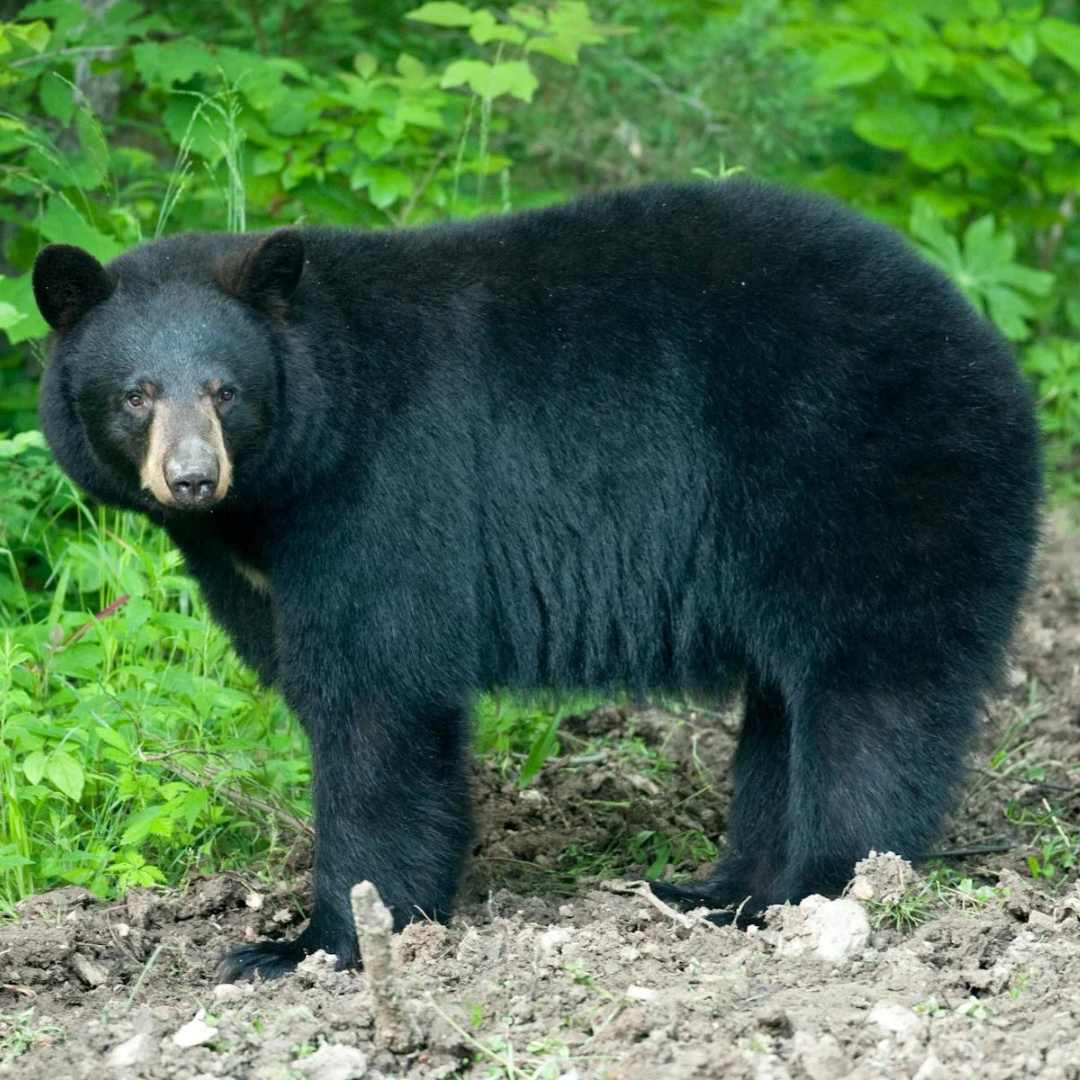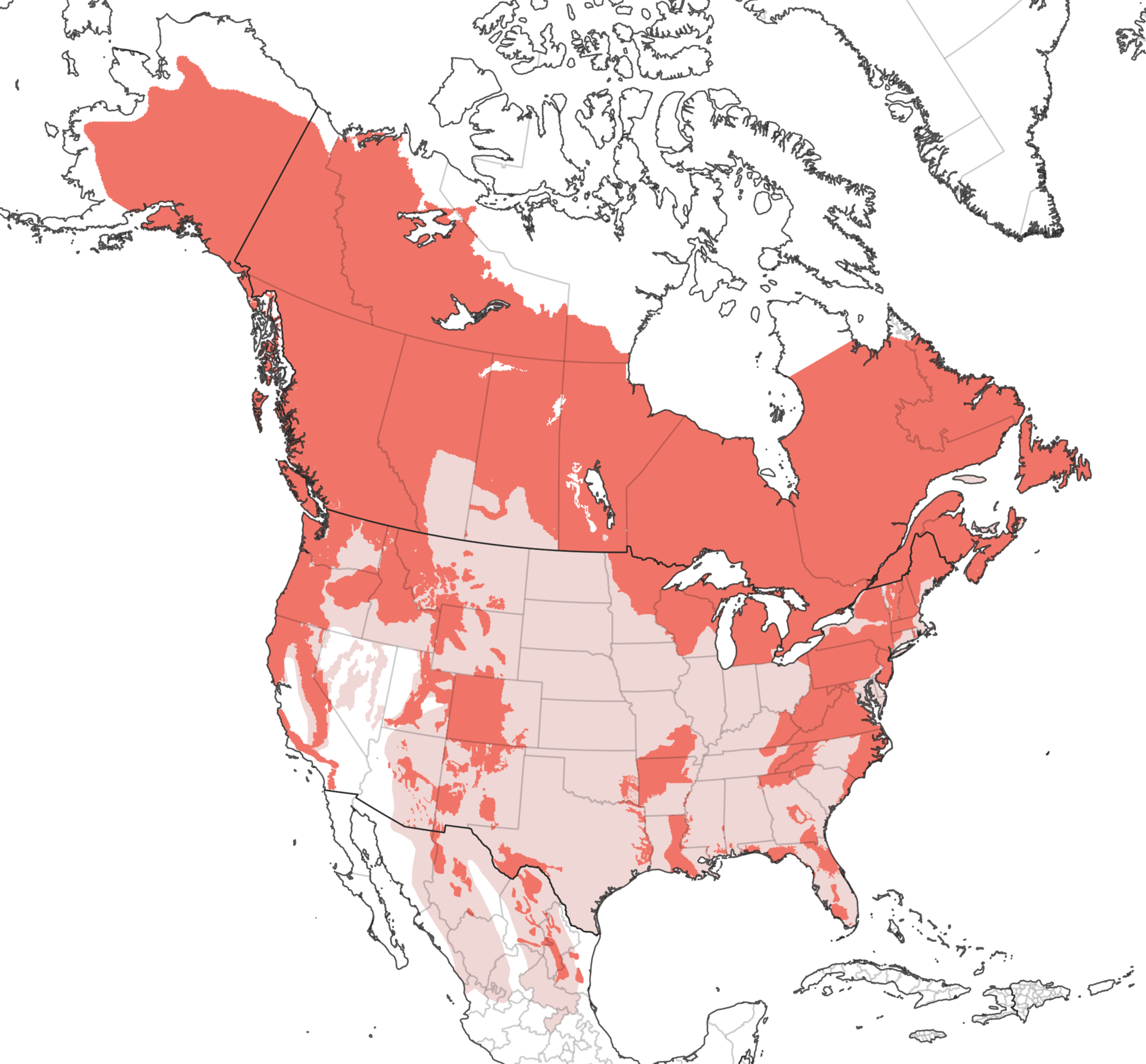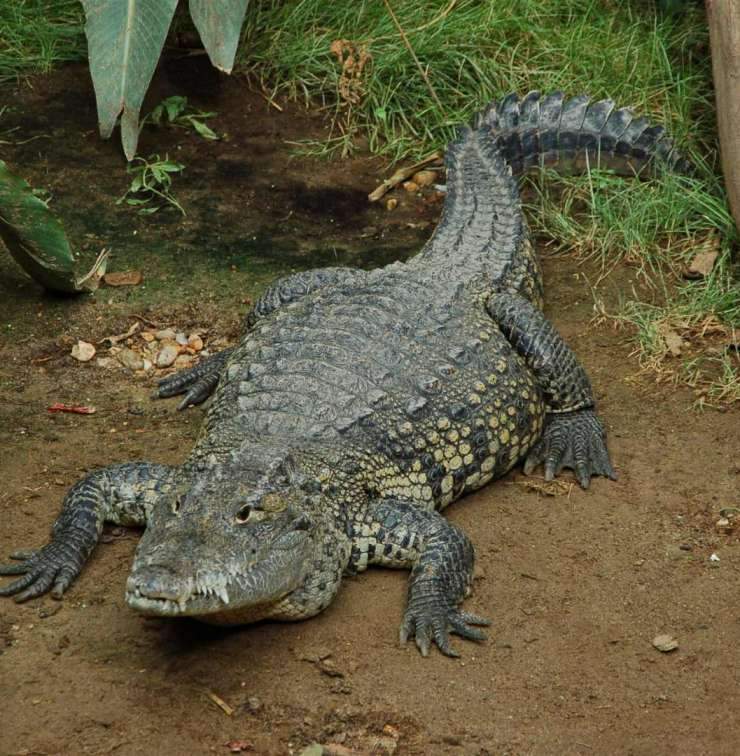Characteristics
The American black bear is the smallest North American bear. It is usually black with a tan muzzle and a white patch on its chest. Black bears in the west may be cinnamon brown, and in parts of British Columbia and the Yukon Territory in Canada the black bear may even be silver-gray or white.
The black bear has small, rounded ears and inch long claws on its feet. The black bear doesn’t have a large shoulder hump like the brown, or grizzly bear. The black bear stands about three feet from shoulder to feet and it’s 4-6 feet from head to toe. Males are usually much larger than females. The male usually weighs between 130 to 350 pounds, but it can weigh as much as 600 pounds. The female weighs 90 to 175 pounds
Range
The black bear is found in most of Alaska southeastward through Canada to Minnesota, Wisconsin, Michigan, and the Canadian Maritimes and south through New England, New York, Pennsylvania, and the Appalachian Mountains to Florida. On the west coast, it is found south from Alaska through northern California and the Rocky Mountain states to Mexico. It is also found in Missouri, Arkansas, and Oklahoma.
Habitat
The black bear is found in a variety of habitats with tree-covered areas and meadows. It requires areas with lots of vegetation for cover and shrubs and other plants for food. It can be found in mountain areas, swamps, and forests. The black bear has a home range of about ten square miles. The home range of the male is usually larger than the home range of the female.
Diet
Although the black bear is in the carnivora order, it is really an omnivore, and most of its diet is made up of plants. It eats twigs, buds, leaves, nuts, roots, fruit, corn, and berries. It also eats bees and honey and it tears up rotting logs to get at grubs, beetles, and insects. The black bear also catches fish and small to medium-sized mammals. It also eats carrion.
In the summer, the black bear eats lots of foods that are rich in carbohydrates like berries. The black bear can gain as much as 30 pounds a week in the summer! It needs the extra weight to survive in the winter!
In the colder parts of its range, the black bear hibernates. It finds a place to spend the winter in a cave, under the roots of a fallen tree, in a crevice, in a hollow tree or log, or in a den it digs out. When it finds a place to hibernate, it curls up into a ball, places its head between its front paws, and goes to sleep! During hibernation, the black bear’s heart beat slows to conserve energy. The black bear can be roused during hibernation, although it may take it a while for it to wake up! In the warmer parts of its range, the black bear can be active year-round..
Life Cycle
The black bear mates in June and July. The female gives birth to 1-5 cubs in January or February. The cubs are naked and blind at birth and weigh only 7 ounces! By the spring, the cubs weigh about ten pounds and begin to explore their environment with their mother. The cubs learn how to find food and survive from their mother during the spring, summer, and fall. The cubs are weaned when they are 6-8 months old, but they stay with their mother through the winter. In the spring, they leave to establish their own territory.
Behavior
Except for during the mating season and when raising young, the black bear is a solitary animal. The black bear is usually crepuscular. That means it is active in the early morning and in the evening! It runs at speeds of up to 30 miles per hour and it is an excellent swimmer and tree climber. The black bear has poor eyesight, but it has an excellent sense of hearing and a keen sense of smell.
Enough American black bears are living in our forests that the IUCN considers them a species of Least Concern, even though some subspecies may be under threat.
Conservationists have petitioned for the Florida and Louisiana black bear subspecies to be considered for protection, but their populations are thought to be stable enough that they were removed from the Federal List of Endangered and Threatened Wildlife some years ago.
Physical Description
Tigers have reddish-orange coats with prominent black stripes, white bellies and
white spots on their ears. Like a human fingerprint, no two tigers have the exact
same markings. Because of this, researchers can use stripe patterns to identify
different individuals when studying tigers in the wild. Tigers are powerful hunters
with sharp teeth, strong jaws and agile bodies. They are the largest terrestrial
mammal whose diet consists entirely of meat. The tiger’s closest relative is the lion.
In fact, without fur, it is difficult to distinguish a tiger from a lion.
Size
Tigers are the largest cat species in the world, and the Amur tiger is the largest
subspecies with males weighing up to 660 pounds (300 kilograms) and measuring 10
feet (3 meters). Sumatran tigers are the smallest subspecies, maxing out at 310
pounds (140 kilograms) and 8 feet (2.4 meters). Female tigers of all subspecies tend
to be smaller than their male counterparts.
Native Habitat
Historically, tigers existed throughout much of Eastern and Southern Asia, as well as
in parts of Central and Western Asia and the Middle East, surrounding the Caspian
Sea. Their range has diminished significantly as human populations have expanded.
Itis believed they currently occupy just 7 percent of their historic range.
Presently, tigers are found in a variety of habitats across South and Southeast Asia,
China and Eastern Russia. They thrive in temperate, tropical or evergreen forests,
mangrove swamps and grasslands. Amur tigers are primarily found in Far-East
Russia, although there are small populations across the border into China and
potentially North Korea. Sumatran tigers are found only on the Indonesian island of
Sumatra. A tiger’s range within these regions is determined by the availability of
prey.
Communication
Despite their solitary nature, communication is a very important part of tigers’
behavioral ecology. They communicate through vocalizations, such as roaring,
grunting and chuffing, and through signals, such as scent marking and scratches on
trees. Tigers are fiercely territorial animals, so these signals are particularly
important to communicating where one tiger’s home range ends and another’s
begins.
Food/Eating Habits
Tigers are solitary ambush predators that rely on stealth and strength to take down
prey. These apex predators primarily hunt large ungulates, such as wild boar and
deer, but are also known to consume monkeys, buffalo, sloth bears, leopards and
even crocodiles. When tigers are found in close proximity to humans, they may also
feed on domestic animals, such as cattle or goats. Tigers are adept swimmers and
have even been recorded hunting in the wild.
These powerful cats hunt primarily at night, using sight and sound to identify prey.
Their striped coats help them blend into their surroundings, where they lie in wait for
prey to pass by. At the opportune moment, tigers pounce on their prey, take it to the
ground and finish the kill by breaking or biting the neck. Tigers hunt about once a
week and consume as much as 75 pounds (34 kilograms) of food in one night.
At the Zoo, tigers eat ground beef, and their diet is supplemented with enrichment
items each week. They receive knucklebones or cow femurs twice a week and rabbits
once a week to exercise their jaws and keep their teeth healthy.
Social Structure
Tigers are solitary creatures, except when mating or raising young. Cubs stay with
their mothers until they learn to hunt successfully, usually at about 18 to 24 months
old. They reach full independence after two to three years, at which point they
disperse to find their own territory. Female tigers often remain near their mother’s’
territory, while males disperse farther from home.
Reproduction and Development
Female tigers reach sexual maturity between age 3 and 4. Males are sexually mature
at about 4 or 5 years old. Mating can occur at any time of year but most often takes
place during cooler months between November and April. Tigers are induced
ovulators, which means females will not release eggs until mating occurs. Gestation
lasts approximately 100 days, and females give birth to between one and seven
offspring at a time, averaging between two and four cubs. Once cubs become
independent, at about age 2, females are ready to give birth again. However, if a
female’s offspring do not survive, due to causes such as infanticide or starvation, she
is able to conceive another litter right away.
Lifespan
The life span of tigers in the wild is usually between 10 and 15 years. In human care,
or on rare occasions in the wild, a tiger can live up to 20 years. However,
approximately half of all wild tiger cubs do not survive past the first two years of life.
Only 40 percent of those that reach independence actually live to establish a territory
and produce young. The risk of mortality remains high for adult tigers due to their
territorial nature, which often results in direct competition with conspecifics, or
members of the same species.













